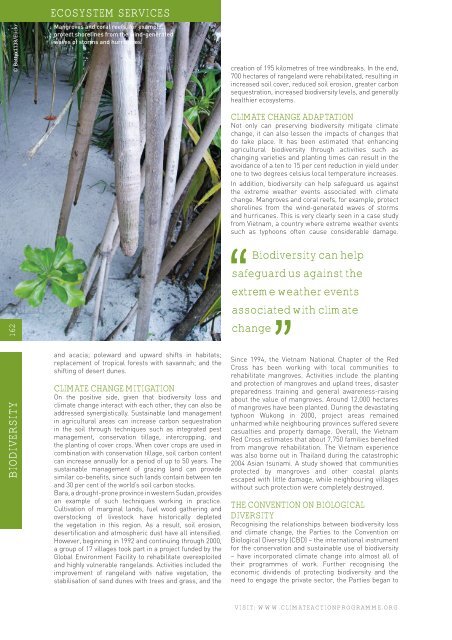Climate Action 2009-2010
Create successful ePaper yourself
Turn your PDF publications into a flip-book with our unique Google optimized e-Paper software.
© Bettyx1138/Flickr<br />
162<br />
ECOSYSTEM SERVICES<br />
Mangroves and coral reefs, for example,<br />
protect shorelines from the wind-generated<br />
waves of storms and hurricanes.<br />
creation of 195 kilometres of tree windbreaks. In the end,<br />
700 hectares of rangeland were rehabilitated, resulting in<br />
increased soil cover, reduced soil erosion, greater carbon<br />
sequestration, increased biodiversity levels, and generally<br />
healthier ecosystems.<br />
CLIMATE CHANGE ADAPTATION<br />
Not only can preserving biodiversity mitigate climate<br />
change, it can also lessen the impacts of changes that<br />
do take place. It has been estimated that enhancing<br />
agricultural biodiversity through activities such as<br />
changing varieties and planting times can result in the<br />
avoidance of a ten to 15 per cent reduction in yield under<br />
one to two degrees celsius local temperature increases.<br />
In addition, biodiversity can help safeguard us against<br />
the extreme weather events associated with climate<br />
change. Mangroves and coral reefs, for example, protect<br />
shorelines from the wind-generated waves of storms<br />
and hurricanes. This is very clearly seen in a case study<br />
from Vietnam, a country where extreme weather events<br />
such as typhoons often cause considerable damage.<br />
“<br />
Biodiversity can help<br />
safeguard us against the<br />
extreme weather events<br />
associated with climate<br />
change<br />
“<br />
BIODIVERSITY<br />
and acacia; poleward and upward shifts in habitats;<br />
replacement of tropical forests with savannah; and the<br />
shifting of desert dunes.<br />
CLIMATE CHANGE MITIGATION<br />
On the positive side, given that biodiversity loss and<br />
climate change interact with each other, they can also be<br />
addressed synergistically. Sustainable land management<br />
in agricultural areas can increase carbon sequestration<br />
in the soil through techniques such as integrated pest<br />
management, conservation tillage, intercropping, and<br />
the planting of cover crops. When cover crops are used in<br />
combination with conservation tillage, soil carbon content<br />
can increase annually for a period of up to 50 years. The<br />
sustainable management of grazing land can provide<br />
similar co-benefits, since such lands contain between ten<br />
and 30 per cent of the world’s soil carbon stocks.<br />
Bara, a drought-prone province in western Sudan, provides<br />
an example of such techniques working in practice.<br />
Cultivation of marginal lands, fuel wood gathering and<br />
overstocking of livestock have historically depleted<br />
the vegetation in this region. As a result, soil erosion,<br />
desertification and atmospheric dust have all intensified.<br />
However, beginning in 1992 and continuing through 2000,<br />
a group of 17 villages took part in a project funded by the<br />
Global Environment Facility to rehabilitate overexploited<br />
and highly vulnerable rangelands. Activities included the<br />
improvement of rangeland with native vegetation, the<br />
stabilisation of sand dunes with trees and grass, and the<br />
Since 1994, the Vietnam National Chapter of the Red<br />
Cross has been working with local communities to<br />
rehabilitate mangroves. Activities include the planting<br />
and protection of mangroves and upland trees, disaster<br />
preparedness training and general awareness-raising<br />
about the value of mangroves. Around 12,000 hectares<br />
of mangroves have been planted. During the devastating<br />
typhoon Wukong in 2000, project areas remained<br />
unharmed while neighbouring provinces suffered severe<br />
casualties and property damage. Overall, the Vietnam<br />
Red Cross estimates that about 7,750 families benefited<br />
from mangrove rehabilitation. The Vietnam experience<br />
was also borne out in Thailand during the catastrophic<br />
2004 Asian tsunami. A study showed that communities<br />
protected by mangroves and other coastal plants<br />
escaped with little damage, while neighbouring villages<br />
without such protection were completely destroyed.<br />
THE CONVENTION ON BIOLOGICAL<br />
DIVERSITY<br />
Recognising the relationships between biodiversity loss<br />
and climate change, the Parties to the Convention on<br />
Biological Diversity (CBD) – the international instrument<br />
for the conservation and sustainable use of biodiversity<br />
– have incorporated climate change into almost all of<br />
their programmes of work. Further recognising the<br />
economic dividends of protecting biodiversity and the<br />
need to engage the private sector, the Parties began to<br />
V I SIT: WWW.CLIMATEACTIONPROGRAMME.ORG












